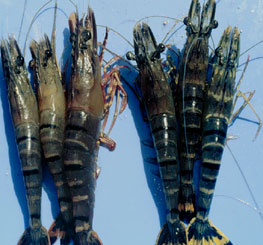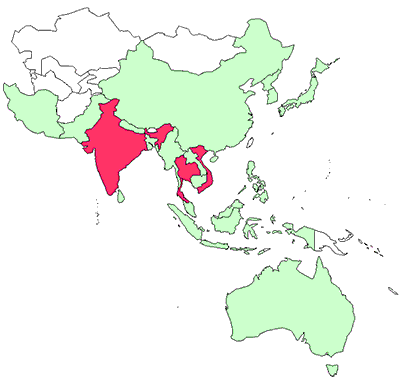Diseases of crustaceans
Viral diseases—Yellowhead disease
CLICK ON IMAGE TO ENLARGE

Source: DV Lightner
Signs of disease
Important: animals with disease may show one or more of the signs below, but disease may still be present in the absence of any signs.
Disease signs at the farm level
- moribund prawns aggregate near surface at pond edges
- infected 5–15 gram prawns begin feeding at abnormally high rate for several days and then cease feeding entirely
- mass mortality three days after cessation of feeding
Clinical signs of disease in an infected animal
- white, yellow or brown gills
- yellowing of the cephalothorax and general bleaching of body
- yellow, swollen digestive gland makes head appear yellow
Disease agent
The causative agent of yellowhead disease is yellowhead virus (YHV), a corona-like RNA viruses in the genus Okavirus, family Ronaviridae and order Nidovirales.
Host range
YHV is highly infectious for most known species of cultivated penaeid prawns.
Crustaceans known to be susceptible to yellowhead disease:
black tiger prawn* (Penaeus monodon) - primarily
Gulf banana prawn* (Penaeus merguiensis)
northern white shrimp* (Penaeus setiferus)
prawn* (Palaemon styliferus)
red endeavour prawn* (Metapenaeus ensis)
tropical krill* (Acetes spp)
blue shrimp (Penaeus stylirostris)
northern brown shrimp (Penaeus aztecus)
northern pink shrimp (Penaeus duorarum)
Pacific white shrimp (Penaeus vannamei)
* naturally susceptible (other species have been shown to be experimentally susceptible)
Until proven otherwise, it should be assumed that most penaeid prawns worldwide are susceptible to infection with yellowhead disease.
Presence in Asia–Pacific

Yellowhead disease has been officially reported from India, Thailand and Vietnam.
Epidemiology
- The tiger prawn suffers acute epidemics, with mortality reaching 100% within 3–5 days from first appearance of the gross signs.
- Transmission is horizontal, direct from the water column and through ingestion of infected material.
- Tiger prawns younger than 15 days postlarvae (PL-15) are fairly resistant to yellowhead disease compared to those from PL-20–25 to subadult, which are highly susceptible.
- Massive mortality usually affects early to late juvenile stages in rearing ponds.
- There appear to be at least four types of virus in the YHV group. Only yellowhead virus has been reported to cause yellowhead disease.
- Vectors may include asymptomatic carrier crustaceans.
Gill-associated virus, which has a similar ultrastructure to that of YHV, has been reported from Australia:
Comparison of DNA sequences of reverse-transcription polymerase chain reaction (RT PCR) products from YHV and GAV suggests that they are closely related, but distinctly different viral strains or species.
Differential diagnosis
The differential diagnostic table and the list of similar diseases appearing at the bottom of each disease page refer only to the diseases covered by this field guide. Gross signs observed might well be representative of a wider range of diseases not included here. Therefore, these diagnostic aids should not be read as a guide to a definitive diagnosis, but rather as a tool to help identify the listed diseases that most closely account for the gross signs.
Similar diseases
Sample collection
Because of uncertainty in differentiating diseases using only gross signs, and because some aquatic animal disease agents might pose a risk to humans, you should not try to collect samples unless you have been trained. Instead, you should phone your national hotline number and report your observations. If samples have to be collected, the agency taking the call will advise you on what you need to do. Local or district fisheries/veterinary authorities could advise you on sampling.
Emergency disease hotline
For your national emergency disease hotline number, see Whom to contact if you suspect a disease.
Further reading
http://www.oie.int/aac/eng/cards/en_diseasecard.htm
The currently accepted procedures for a conclusive diagnosis of yellowhead disease are summarised at http://www.oie.int/eng/normes/fmanual/A_00050.htm
These hyperlinks were correct and functioning at the time of publication.

